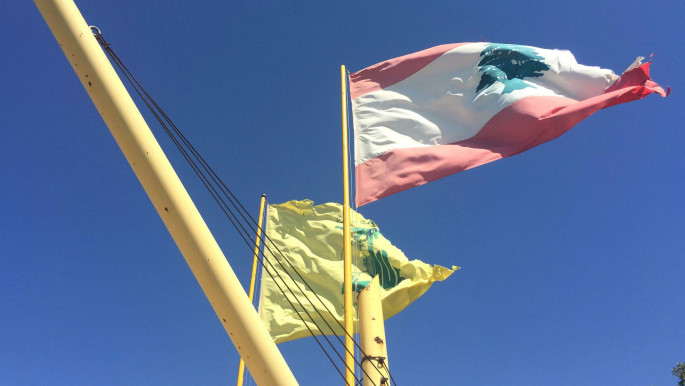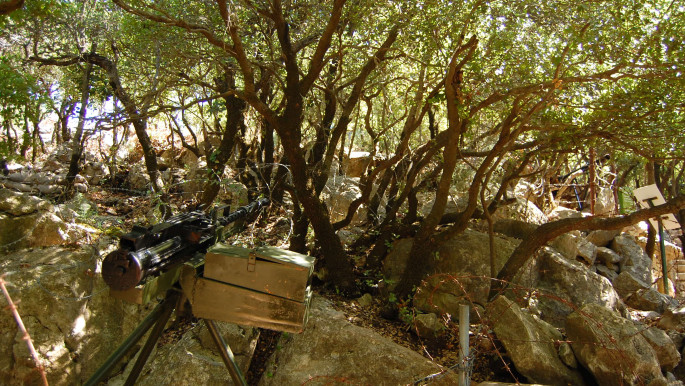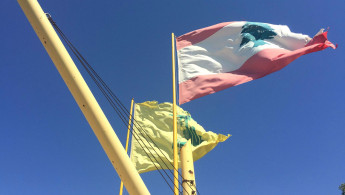Retelling history: Inside the Hizballah museum
Retelling history: Inside the Hizballah museum
The guerrilla enclosure in southern Lebanon celebrates the armed movement's 'victory' over Israel with triumphalist curation, writes Marie Britt.
5 min read
Mleeta was a Hizballah stronghold during the Israeli occupation [All photos: Marie Britt]
History, it is said, is written by the victors. Here in southern Lebanon, a sprawling museum tells the story of how Lebanese fighters fought the Israeli army, which left the country in 2000 after over two decades of incursions and occupation.
The Mleeta Resistance Tourist Landmark, otherwise known as the Mleeta museum, sits on a mountaintop in the village of the same name.
More than 80 kilometres south of Beirut, and 45 kilometres from the border with Israel, the museum perches amid the rocky, tree-covered terrain of Mount A'mel.
Fighters belonging to Hizballah, the Lebanese Shia movement, fought here - and the party has erected an extensive and at times surreal museum outlining the history of their fight against Israel.
The Israeli army completed its unilateral withdrawal of South Lebanon on May 24, 2000. Israel still controls Shebaa Farms, a strip of land near the Lebanese-Syrian border, and the Israeli-occupied, Syrian Golan Heights, which Hizballah and other Lebanese leaders say belongs to Lebanon.
Reporters described Israel's withdrawal from the south at the time as "chaotic" and a "fiasco", as Israeli soldiers retreated under cover of darkness and Israeli air force sorties.
"We are not in the worst-case scenario, which is a good thing," then-Israeli Prime Minister Ehud Barak said at the time, according to The Los Angeles Times. Barak pushed for Israel's unilateral withdrawal, despite opposition from segments of the Israeli public and some Israeli military leaders.
"We are not fleeing. We decided to leave, and we knew that Hizballah would try and claim credit for our departure."
And Hizballah clearly sees the Israelis' departure as a victory, calling it the first time in the history of the Arab-Israeli conflict that a popular armed resistance freed Arab lands.
The Mleeta Resistance Tourist Landmark, otherwise known as the Mleeta museum, sits on a mountaintop in the village of the same name.
More than 80 kilometres south of Beirut, and 45 kilometres from the border with Israel, the museum perches amid the rocky, tree-covered terrain of Mount A'mel.
Fighters belonging to Hizballah, the Lebanese Shia movement, fought here - and the party has erected an extensive and at times surreal museum outlining the history of their fight against Israel.
The Israeli army completed its unilateral withdrawal of South Lebanon on May 24, 2000. Israel still controls Shebaa Farms, a strip of land near the Lebanese-Syrian border, and the Israeli-occupied, Syrian Golan Heights, which Hizballah and other Lebanese leaders say belongs to Lebanon.
Reporters described Israel's withdrawal from the south at the time as "chaotic" and a "fiasco", as Israeli soldiers retreated under cover of darkness and Israeli air force sorties.
"We are not in the worst-case scenario, which is a good thing," then-Israeli Prime Minister Ehud Barak said at the time, according to The Los Angeles Times. Barak pushed for Israel's unilateral withdrawal, despite opposition from segments of the Israeli public and some Israeli military leaders.
"We are not fleeing. We decided to leave, and we knew that Hizballah would try and claim credit for our departure."
And Hizballah clearly sees the Israelis' departure as a victory, calling it the first time in the history of the Arab-Israeli conflict that a popular armed resistance freed Arab lands.


Israel first entered Lebanon in 1978 and launched a full-scale invasion in 1982, seizing control of parts of the capital, Beirut, and other major cities, in what it described as an effort to root out Palestinian fighters.
Israel withdrew from some occupied Lebanese territory between 1983 and 1985, including the region of Iqleem al-Tuffah, shown in these images taken from a viewpoint at the Mleeta museum.
But Israel then set up what it described as a "security belt" in southern Lebanon. The military zone measured approximately 650 square kilometres and encompassed dozens of Lebanese villages.
During its occupation, Israel worked alongside the South Lebanon Army (SLA), a largely Christian, pro-Israel militia, which is also condemned throughout the Mleeta museum installations and introductory video.
At least 5,000 SLA fighters and their family members sought refuge in Israel after the withdrawal, according to a Los Angeles Times report. Several hundred others surrendered as they abandoned their military positions and equipment during and after the Israeli withdrawal.
But Israel then set up what it described as a "security belt" in southern Lebanon. The military zone measured approximately 650 square kilometres and encompassed dozens of Lebanese villages.
During its occupation, Israel worked alongside the South Lebanon Army (SLA), a largely Christian, pro-Israel militia, which is also condemned throughout the Mleeta museum installations and introductory video.
At least 5,000 SLA fighters and their family members sought refuge in Israel after the withdrawal, according to a Los Angeles Times report. Several hundred others surrendered as they abandoned their military positions and equipment during and after the Israeli withdrawal.

Symbolism was the word used most often by a museum tour guide, as he explained each item on display in a vast, open-air pit at the centre of the site called "The Abyss".
The display includes an Israeli Merkava tank with its barrel twisted into a knot, a fake gravesite for Israeli soldiers, and an Israeli military vehicle caught in a web of twisted metal.
That installation is a reference to a speech given by Hizballah Secretary-General Hassan Nasrallah after the Israeli withdrawal, in which he described Israel as "more fragile than the spider web".
That installation is a reference to a speech given by Hizballah Secretary-General Hassan Nasrallah after the Israeli withdrawal, in which he described Israel as "more fragile than the spider web".
Also on display is a collection of cluster bombs, which human rights groups condemned Israel for using in Lebanon in 1978 and during the 1980s. An Israeli military commander also admitted that the army dropped more than a million cluster sub-munitions on Lebanon in the later war between its army and Hezbollah in 2006.
Cluster bombs release hundreds of sub-munitions over a vast area. Their use is widely condemned because many of the projectiles don't explode on impact, becoming de facto land mines that pose serious dangers to civilians, especially children.
Visitors walk through a path cut through the mountainous terrain, which the museum says was used by thousands of fighters. "From here, they embarked on military operations against enemy outposts, reaching all the way to the occupied buffer zone," a trail marker reads.
Cluster bombs release hundreds of sub-munitions over a vast area. Their use is widely condemned because many of the projectiles don't explode on impact, becoming de facto land mines that pose serious dangers to civilians, especially children.
Visitors walk through a path cut through the mountainous terrain, which the museum says was used by thousands of fighters. "From here, they embarked on military operations against enemy outposts, reaching all the way to the occupied buffer zone," a trail marker reads.

This reconstructed barricade is where Abbas Moussawi, a Shia cleric and former secretary-general of Hizballah, reportedly prayed with the group's fighters and encouraged them ahead of battle.
Israel assassinated Moussawi in 1992. Helicopter gunships fired on his car in southern Lebanon. His wife, son, and four others were also killed.
Israel assassinated Moussawi in 1992. Helicopter gunships fired on his car in southern Lebanon. His wife, son, and four others were also killed.



This tunnel initially measured one square metre and served as a bunker against Israeli aerial bombardments, according to a sign marking its entrance.
It was later transformed into a 200-metre tunnel and military base, complete with a command centre, kitchen, prayer room and other underground rooms.
According to the museum, 1,000 men constructed the tunnel and more than 7,000 used it as a military base.
As visitors emerge from the tunnel, visitors see the word Hizballah - "Party of God" in Arabic - emblazoned on the wall.



Rocket launchers and other weapons have been set up under the trees.
Construction on the museum took approximately three years, according to curators.
During the fighting, Israel reportedly set up fortified bases in the mountains of southern Lebanon.
Hizballah fighters engaged in what they called the "War of Bases" from 1985 onwards, and Mleeta served as one of their strongholds.
The last stop on a tour of the museum is a dark room where Israeli small munitions and military equipment are on display behind glass cases.
Construction on the museum took approximately three years, according to curators.
During the fighting, Israel reportedly set up fortified bases in the mountains of southern Lebanon.
Hizballah fighters engaged in what they called the "War of Bases" from 1985 onwards, and Mleeta served as one of their strongholds.
The last stop on a tour of the museum is a dark room where Israeli small munitions and military equipment are on display behind glass cases.
A video showing Israeli soldiers withdrawing from Lebanon - and mourning at funerals for killed comrades - plays in one corner, as dramatic, triumphant music loudly pounds through the room.
Elsewhere, posters quote Israeli leaders Shimon Peres, Ariel Sharon and Yitzhak Shamir, the former prime minister.
"A few hundred Hizballah fighters force the strongest state in the Middle East to withdraw in this despondent way?" Shamir is quoted as telling Arutz Sheva radio in 2000.
"We have always proven to the Arabs that they better not try to force us to offer concessions by force, because in the end they will be the ones to offer concessions. Yet Hizballah proved that there are Arabs of a different kind."
Elsewhere, posters quote Israeli leaders Shimon Peres, Ariel Sharon and Yitzhak Shamir, the former prime minister.
"A few hundred Hizballah fighters force the strongest state in the Middle East to withdraw in this despondent way?" Shamir is quoted as telling Arutz Sheva radio in 2000.
"We have always proven to the Arabs that they better not try to force us to offer concessions by force, because in the end they will be the ones to offer concessions. Yet Hizballah proved that there are Arabs of a different kind."



